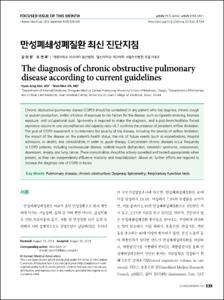KUMEL Repository
1. Journal Papers (연구논문)
1. School of Medicine (의과대학)
Dept. of Internal Medicine (내과학)
만성폐쇄성폐질환 최신 진단지침
- Keimyung Author(s)
- Kim, Hyun Jung
- Department
- Dept. of Internal Medicine (내과학)
- Journal Title
- 대한의사협회지
- Issued Date
- 2018
- Volume
- 61
- Issue
- 9
- Abstract
- Chronic obstructive pulmonary disease (COPD) should be considered in any patient who has dyspnea, chronic cough or sputum production, and/or a history of exposure to risk factors for the disease, such as cigarette smoking, biomass exposure, and occupational dust. Spirometry is required to make the diagnosis, and a post-bronchodilator forced expiratory volume in one second/forced vital capacity ratio <0.7 confirms the presence of persistent airflow limitation. The goal of COPD assessment is to determine the severity of the disease, including the severity of airflow limitation, the impact of the disease on the patient’s health status, the risk of future events (such as exacerbations, hospital admission, or death), and comorbidities in order to guide therapy. Concomitant chronic diseases occur frequently in COPD patients, including cardiovascular disease, skeletal muscle dysfunction, metabolic syndrome, osteoporosis, depression, anxiety, and lung cancer. These comorbidities should be actively surveilled and treated appropriately when present, as they can independently influence mortality and hospitalization. Above all, further efforts are required to increase the diagnosis rate of COPD in Korea.
- Alternative Title
- The diagnosis of chronic obstructive pulmonary disease according to current guidelines
- Keimyung Author(s)(Kor)
- 김현정
- Publisher
- School of Medicine (의과대학)
- Citation
- Hyun Jung Kim and Yeon-Mok Oh. (2018). 만성폐쇄성폐질환 최신 진단지침. 대한의사협회지, 61(9), 539–544. doi: 10.5124/jkma.2018.61.9.539
- Type
- Article
- ISSN
- 2093-5951
- Source
- https://jkma.org/DOIx.php?id=10.5124/jkma.2018.61.9.539
- Appears in Collections:
- 1. School of Medicine (의과대학) > Dept. of Internal Medicine (내과학)
- 파일 목록
-
-
Download
 oak-2018-1760.pdf
기타 데이터 / 4.29 MB / Adobe PDF
oak-2018-1760.pdf
기타 데이터 / 4.29 MB / Adobe PDF
-
Items in Repository are protected by copyright, with all rights reserved, unless otherwise indicated.